Iraq Exhibition
Here are some photos form my solo exhibition in the Ismail Khayat gallery in Iraq June 2012.
Creative, business builder & social entrepreneur
Here are some photos form my solo exhibition in the Ismail Khayat gallery in Iraq June 2012.
A video showing the dramatic painting of a mountain in Iraq as a performance by Ben Hodson and to reenact an original work by Ismail Khayat in 2000. Ben paints Peace for Luton on the side of the mountain to make a beautiful symbol for peace and hope for his home town of Luton, UK. Luton has suffered heightened tensions since the troops returned from Iraq in 2009.
I claim not to be a politically motivated artist, however, most of my current work involves engaging with themes of war, social injustice/inequality and social regeneration, which are highly political. When Jeremy Deller was interviewed by the New Museum about his Iraqi project “It is What It Is” , “… he strenuously asserts that this isn't a political project—to which you might well ask, What could be more political than selecting which voices will represent Iraq to an information-hungry public?" Ben Davis, 09. Deller too does not primarily seem driven by a political agenda, he instead simply attempts to “encourage conversations about our world” Deller J, 09. In a similar way, my work does not intend to preach, rather open the doors to dialogue and engagement with difficult subjects. I went to see Deller’s retrospective show at the Hayward Gallery and sat down with an Iraqi artist, Bassim Mehdi as part of the project. The project attempted to create a dialogue around Iraq as a subject. Deller originally toured the exhibition across America with a number of objects including a bombed out car, an Iraqi civilian and an American Marine.
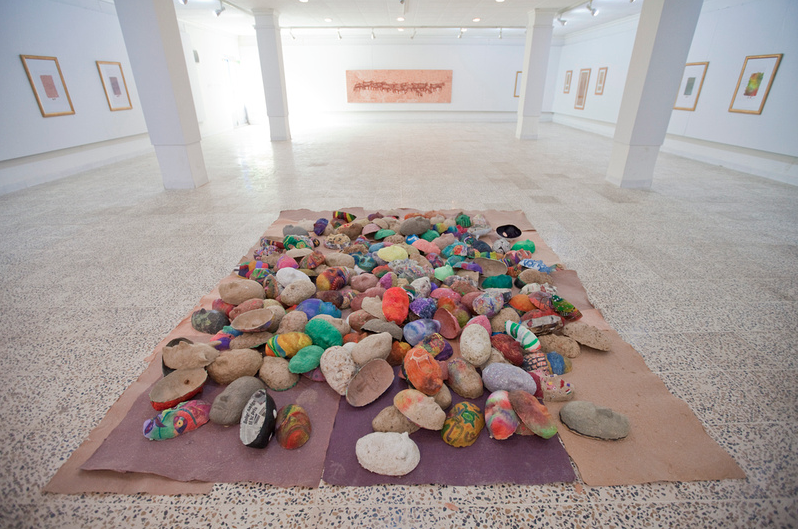
When I went to Amna Suraka in 2009 it was barely more then an empty shell of the prison and torture chamber it had been. When I returned in 2012, it had become the location of and a symbol for Kurdish art and culture. As Amna Suraka had primarily been used to oppress the Kurds in one of their cultural capitals: Sulaymaniyah. This subversion is a wonderful example of art being used to bring hope and make a positive change.
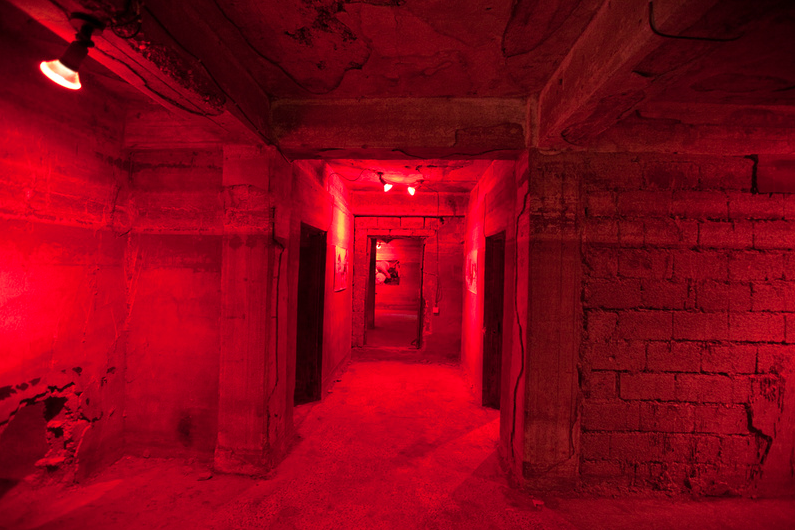
Extract from news article:
Luton artist, Ben Hodson and creative director of ATP Media, has recently returned from an incredible trip to Iraq. The 26 year old travelled with fellow director and storyteller Ian Rowlands, 49, to Iraq last week. The purpose of the trip was somewhat unusual.
With the help of local Iraqi artists, they literally painted the side of a mountain on the site of a dramatic peace project on the turn of the millennium, created by internationally renowned artist, Ismail Khayat. Ben explains “When Ismail initially did the project it was about bringing peace to two opposing Kurdish factions in the north of the country” “It appears that his intervention as an artist kicked off the peace process and he is widely credited with being instrumental in bringing the two opposing sides together.
Ben is the creative Director of ATP Media, who as a team are working on a documentary to tell some of these stories and many more from Iraq. The film will look to show how creativity and people can help to bring about positive change, even in the most difficult of situations.
With this dramatic re-enactment and performance the agency hopes to use it as a symbol for peace for the country, the region and the world. “Art is not the answer, but it’s a great start. It starts dialogue and helps people engage with difficult subject matters in a way that can bring hope and be constructive.” says Ian. During the trip Ben exhibited a solo exhibition of artwork that was made in Luton, UK. I am passionate about showing the beauty and common humanity in every culture, ours is no different. “As we have exhibited a number of Iraqi exhibitions in England and Wales, it is great to show British people and culture to the Iraqi people themselves."
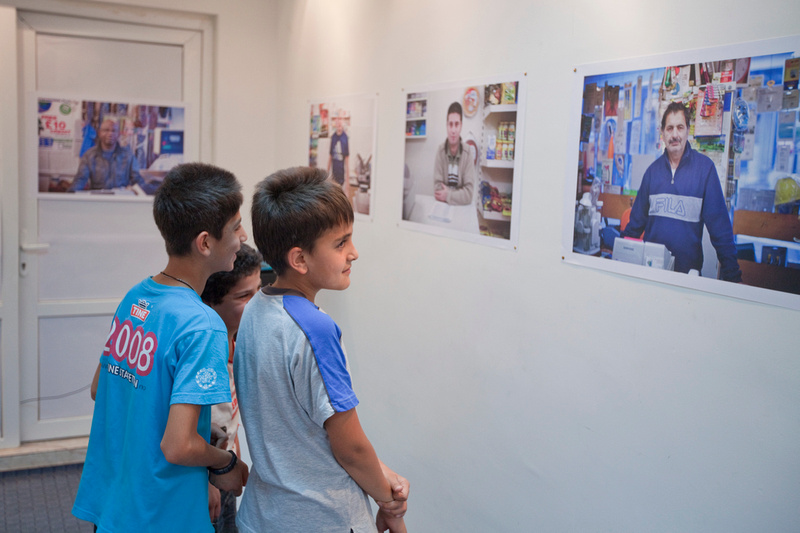
Previously in the UK I have showed people what Iraqi people are like: their lives, their places of work and their homes. I have been attempting to go beyond the media and address some of the stereotypes and assumptions. However, there are direct parallels with what I have been doing and early photography’s relationship to colonisation. I have been researching concepts that touch on colonial and post-colonial theory in art. I would never support a colonial perspective or celebrate its effect on the world, yet I have regularly mimicked/reflected their actions in my own work. In as much as I have photographed distant and ‘exotic’ lands and brought them back to England to present them as an artefact. In an attempt to reject colonial patterns developing in my own practice, I have intentionally taken work back to Iraq that was created in Luton and showcased my own culture to local people. It has become a cultural exchange. The exhibition is part of an on going aim to tell stories and challenge perceptions through my work.
As part of the exhibition I got local people to give their views of the work and how they felt about the work I had been showing in Luton and the rest of the UK.
I collected feedback at the exhibition and the general response was very positive. I have documented the English speaking interviews in this video. The gallery has now mounted the work and is touring it around a number of galleries and locations in the region. It was important that the subject of the exhibition was from Luton, this is both because it is where I live and because of the tensions the town is facing.
British people have ideas, pre-conceptions and stereotypes about what people are like in Iraq and the Middle East. Equally people who live in these areas have ideas, pre-conceptions and stereotypes about what British people are like. I aimed to show some common humanity and the beauty and dignity to be found in every culture and society. There are three collections of work I exhibited in Iraq; Firstly, a project called Lutopia, which is reproductions of large scale photomontages, depicting everyday scenes from Luton in the UK. Secondly, the portraits of everyday people living in the town. Thirdly, there are prints showing some of the exhibitions and events in the UK, that showcased work by Kurdish and Arab artists and photographers. The project attempts to challenge sensationalist or traditional art responses to war and war zones. I tried to address the cross cultural notion of the “other” or foreigner by showing common humanity.
So far the project has exceeded my expectations. I hoped that my intervention in Iraq would get out a message of peace, art and hope. Due to all the media attention in Iraq and subsequent coverage in the UK, that message appears to be getting out there.
As the result of a bitter and violent war between rival Kurdish factions (the PDK and PUK) a well-known Kurdish artist (he is often referred as the Grandfather of Kurdish art by colleagues!) and a former minister of Arts and Culture Ismail Khayat decided that something needed to be done to help bring the sides closer. He had slowly been gaining support for his work which directly addresses the need for peace in the region. This quest found expression when he painted the side of a mountain in the place where a lot of the killing took place. Using his very distinctive, figurative and colourful style he painted rocks, trees, bullets and other objects found on the site with bright colours and symbols. He also painted peace slogans and symbols such as “peace for Kurdistan” and “this place is not for fighting but for picnics” on the side of this mountain.
“…….I wonder if we would have ever have seen an end to this bloodshed,….”
He then invited leaders and members of the two warring parties to the site and had them bury stones marked with ‘anger’, ‘hate’, ‘pain’ ‘death’ etc. as well as bullets and shells he had collected during the painting of the mountain as a symbol of them wanting to bury their differences. Although the two parties had already begun a dialogue this event is seen as a major turning point in resolving the issues between them. One artist put it like this “…..without Khayat’s help I wonder if we would have ever have seen an end to this bloodshed, this event is very important in Kurdish history”. As we talked to numbers of people from different walks of life we have found he is not alone in his opinion.
…….that in his late sixties he is still as passionate as ever about bringing peace,
The amazing thing is that in his late sixties he is still as passionate (and energetic!) as ever about bringing peace, not just this region, but anywhere where there is division and conflict. Which is why we have been privileged to be involved in the painting of the mountain again. He, like us, is convinced that art and creativity have a powerful place to play in the world we live. When we first met him 2009 we asked him whether art can change policy or public opinion, his answer had a tone of incredulity as he replied “of course art can change things……artists have the responsibility to try and make the world a better place”. The mountain faces a busy back route between Sulaymaniyah and Erbil and judging from the positive responses we had as traffic went by…..he is still managing to make a difference.
Jeremy Deller put the project together to encourage conversation about our world. The porject is a corner stone of the context for which I create my work and Deller's approach is one of the most inspiring and relevant to my practice.
http://www.guardian.co.uk/artanddesign/2009/apr/14/jeremy-deller-iraq-war-us
The invasion of Iraq, and the continuing occupation, is that kind of war, too. It has released something in art: a rage, a sense of purpose, or perhaps just an extreme nihilism. Two years ago, in a London gallery, I could have sworn I had travelled back to the dada protests that rocked Berlin in 1919. Cardboard figures of US soldiers paraded through a scene spliced together from images of Iraq's war dead. These grotesque, but real, fragments had been found on websites and collaged into a furious installation by Swiss artist Thomas Hirschhorn. The pulverised bodies, photographed by soldiers for reasons that are hard to fathom, were barely recognisable as human.
Jonathan Jones, The Guardian, Tues 14th April 2009.
For videos I have watched about Deller's ambitious project follow this link:
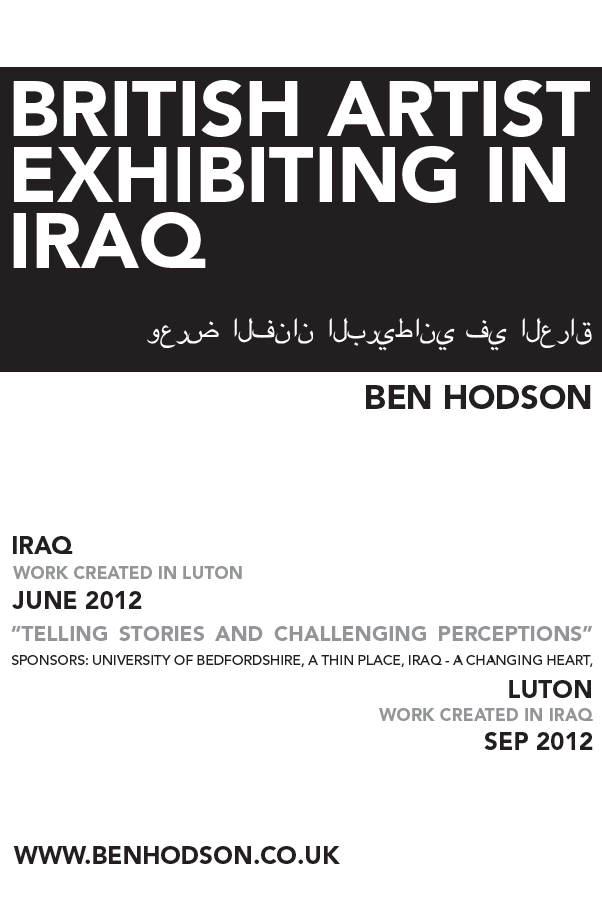
As part of my challenge by Hannah Birkett in a tutorial was to look at creating some promotional material. As the exhibition in Iraq has primarily been organised by people there, I had not considered creating something for people here. As the work being shown is varied and the content is less important then the act of actually exhibiting there, it is a challenge to design a poster with no examples of work in it. I do not consider myself a strond designer, so this is a brave attempt for me.

I have been preparing the prints for my show in the Ismail Khayat Gallery in Iraq. Due to the challenges over there and the need to transport the exhibition, there are a number of restrictions on the work. This has meant I have had to cut out some of the series and concentrate on the work which will help me accomplish my goals; show work from Luton to people in Iraq, to show them what I have been doing in the UK and to get there responses to both.
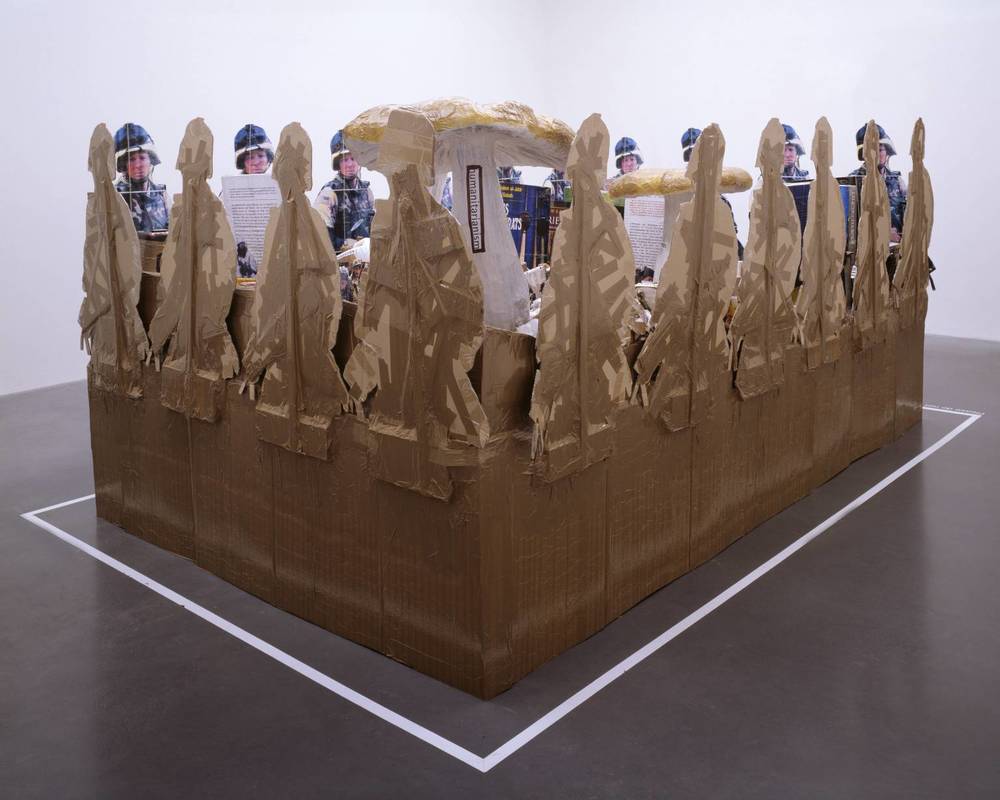
As I look at war artists, I have come across the passionate work by Swiss artist Thomas Hirschhorn. This peice here was shown in the Tate Modern is a politically charged sculpture which comments on the challenges and fragility of everything surrounding the Iraq conflict.
http://www.tate.org.uk/art/artworks/hirschhorn-drift-topography-t11885/text-summary
Hirschhorn creates monumental works from the basest of materials. Cardboard, foil, paper and plastic are bound together with tape, in an apparently casual fashion, to form works that are all the more powerful for their obvious instability. In Drift Topography, a ring of US soldiers surround and stand guard over a densely built-up, fenced-in territory. The soldiers themselves, and the weapons they brandish, are larger than life-sized cardboard cutouts. The landscape they guard is equally unstable – a city built from boxes, card, cotton wool and aluminum foil. Vast quantities of generic brown packing-tape hold the whole structure together. Political and historically significant books line the makeshift streets, alongside rows of plastic petrol cans. Paper billboards bear Arabic script enlarged from newspapers, and the bold text of truncated headlines – ‘war’, ‘power’, ‘humanitarian’, ‘globalization’ – are plastered over every surface, echoing the overuse of such terms by the press to the extent of virtual meaninglessness. Over it all, gigantic mushrooms rise out of the centre of the system, evoking nuclear clouds as much as thriving mutant fungi.
Tate.org.uk Accessed May 2012